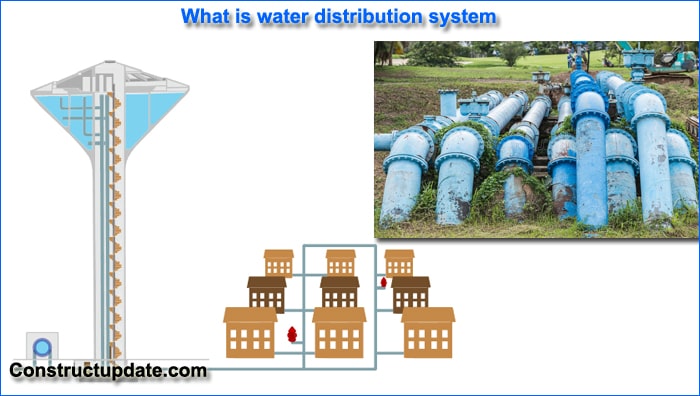Water Distribution System | Methods of water distribution system | Basic Principles of Water Supply Distribution System
A water distribution system is a method of delivering purified water to users.
Pumps, reservoirs, valves, water metres, pipe fittings, etc. are all part of the distribution system.
Every user should receive water whenever needed in an adequate quantity at the necessary pressure without any leaks, according to a good water distribution system.
What Is Water Distribution System?
Water is used by household users for a variety of functions, including drinking, cooking, cleaning, washing hands and bodies, washing clothes, watering animals, irrigating gardens, and frequently for many business activities.
Water can be utilised for a variety of purposes, and the sources that are available can change with the seasons.
The water supply system is followed by the water distribution system. A domestic water supply system is a feature that allows public utilities to provide water from a source to a residence with the proper quality, quantity, and pressure, typically using a network of pumps and pipes.

Methods of the water distribution system
The area’s topography affects the distribution strategy. You could use the following distribution system or method:
- Gravity system
- Combined gravity and pumping system
- Pumping system
Gravity system
In the gravity system, the water supply source is positioned in relation to the distribution area in such a way that water is readily available with sufficient pressure at different parts of the area. In most cases, no pumping is necessary.
Since the water supply source and the purification units are both on hills, it could be necessary to pump water from the raw water source to the purification works.
Combined gravity and pumping system
In the majority of situations, this system is used. Typically, the region of distribution and the water purifying facility is almost at the same level. Following that, as shown, the water from the raised reservoir flows according to gravity.
Pumping system in the water distribution system
To create the necessary pressure in this method, water is pushed directly into the distribution system. A system like that is not preferred. In most cases, two pumps must be operated at different speeds in accordance with the variance in the distribution, first pumping raw water from the source to the treatment facilities.
Basic Principles of Water Supply Distribution System
- In the distribution pipelines, the quality of the water shouldn’t degrade.
- Water should be able to be delivered with sufficient pressure heads by the supply system to all intended locations.
- It should be able to supply the necessary quantity of water for fighting fires.
- No consumer should be without a water supply while any part of the system is being repaired, according to the pipe layout.
- Preferably, all of the distribution system’s pipes should be installed one metre away from or above the sewer lines.
- To minimise losses caused by leakage, the pipe system should be reasonably water-tight.
Types of Distribution Network In Water Distribution System
There are 4 types of distribution network systems:
- Dead End or Tree system
- Gridiron System
- Circular or Ring System
- Radial System
1. Dead End or Tree System
A tree system is another name for the dead-end system.
This system consists of a single main pipe from which many sub-mains branch out, and several branch pipes, known as laterals, from each sub-main. Different houses receive connections from laterals.
2. Grid Iron System
Reticulation or an interlaced system are other names for a grid iron water delivery system.
One main pipe goes through the middle of the entire system, and it is connected to other pipes via branches and laterals that are laid out in a grid.
Dead ends are laminated and water travels through several paths since the mains, branches, and laterals are connected.
Water can be routed to the afflicted region during a fire by closing cut-off valves on the pipes in other places.
Because there are no dead ends, the likelihood of recontamination is quite low.
3. Circular or Ring System
The supply main forms a ring around the distribution region in the ring water distribution system.
The mains and the branches are cross-connected to one another and to the mains.
For a town with carefully designed streets and roads, this approach is most reliable.
4. Radial System
In this arrangement, the city is divided into sections, each of which has a distribution reservoir that is centrally positioned (elevated).
The centre distribution reservoir is connected to the distribution pipes, which are radially set out and point outward.
Purposes of a water distribution system
- The hourly change in demand is absorbed by them.
- If pumps are required, the presence of a reservoir enables them to run continuously.
- They serve as emergency storage for situations like fire outbreaks, pump failures, or main ruptures.
- The distribution system’s operation becomes relatively simple.




